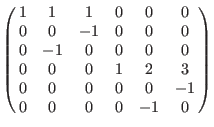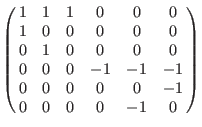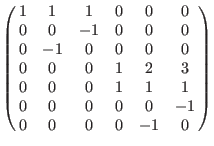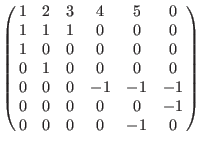| |
 |
 |
 |
 |
 |
 |
 |
 |
 |
B.2.6 Matrix orderings
Let
![]() be an invertible
be an invertible
![]() -matrix with integer coefficients and
-matrix with integer coefficients and
![]() the rows of
the rows of ![]() .
.
The M-ordering < is defined as follows:
![]() and
and
![]() .
.
Thus,
![]() if and only if
if and only if ![]() is smaller than
is smaller than ![]() with respect to the lexicographical ordering.
with respect to the lexicographical ordering.
The following matrices represent (for 3 variables) the global and local orderings defined above (note that the matrix is not uniquely determined by the ordering):
![]() lp:
lp:
 dp:
dp:
 Dp:
Dp:

![]() wp(1,2,3):
wp(1,2,3):
 Wp(1,2,3):
Wp(1,2,3):

![]() ls:
ls:
 ds:
ds:
 Ds:
Ds:

![]() ws(1,2,3):
ws(1,2,3):
 Ws(1,2,3):
Ws(1,2,3):

Product orderings (see next section) represented by a matrix:
![]() (dp(3), wp(1,2,3)):
(dp(3), wp(1,2,3)):

![]() (Dp(3), ds(3)):
(Dp(3), ds(3)):

Orderings with extra weight vector (see below) represented by a matrix:
![]() (dp(3), a(1,2,3),dp(3)):
(dp(3), a(1,2,3),dp(3)):

![]() (a(1,2,3,4,5),Dp(3), ds(3)):
(a(1,2,3,4,5),Dp(3), ds(3)):

Example:
ring r = 0, (x,y,z), M(1, 0, 0, 0, 1, 0, 0, 0, 1); |
which may also be written as:
intmat m[3][3]=1, 0, 0, 0, 1, 0, 0, 0, 1; m; ==> 1,0,0, ==> 0,1,0, ==> 0,0,1 ring r = 0, (x,y,z), M(m); r; ==> // coefficients: QQ ==> // number of vars : 3 ==> // block 1 : ordering M ==> // : names x y z ==> // : weights 1 0 0 ==> // : weights 0 1 0 ==> // : weights 0 0 1 ==> // block 2 : ordering C |
If the ring has
![]() variables and the matrix does not contain
variables and the matrix does not contain
![]() entries, an error message is given.
entries, an error message is given.
WARNING: SINGULAR does not check whether the matrix has full rank. In such a case some computations might not terminate, others may not give a sensible result.
Having these matrix orderings SINGULAR can compute standard bases for any monomial ordering which is compatible with the natural semigroup structure. In practice the global and local orderings together with block orderings should be sufficient in most cases. These orderings are faster than the corresponding matrix orderings, since evaluating a matrix product is time consuming.